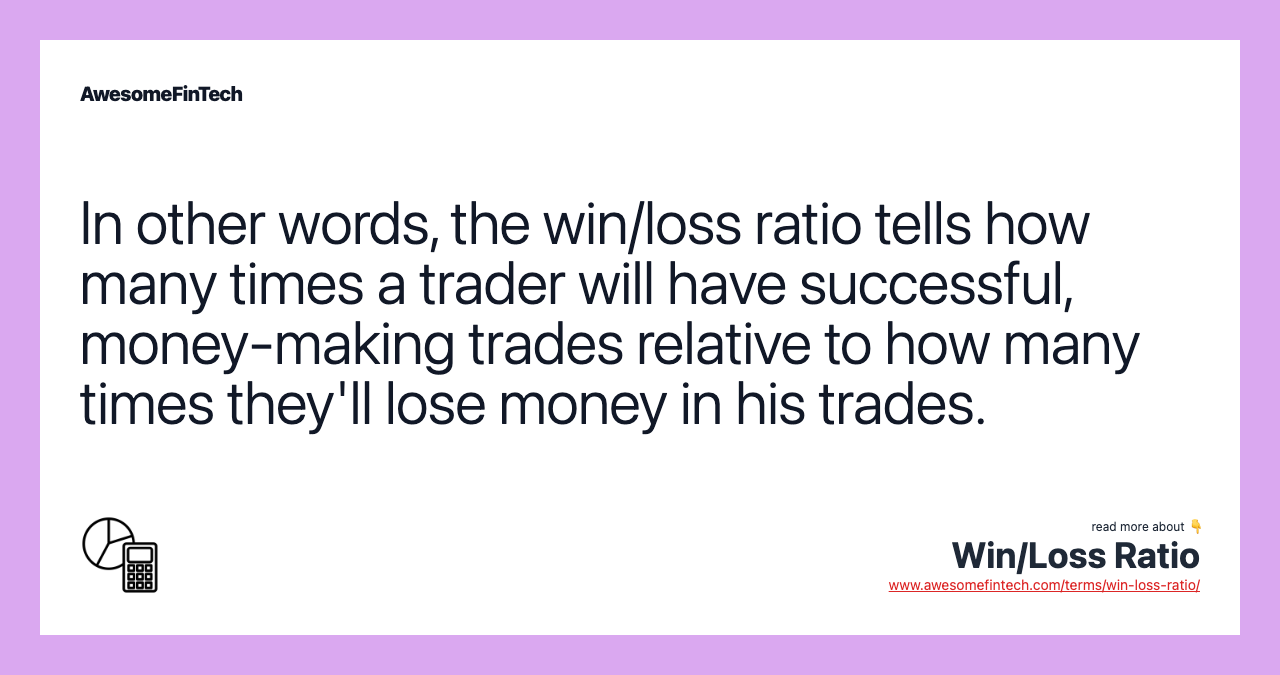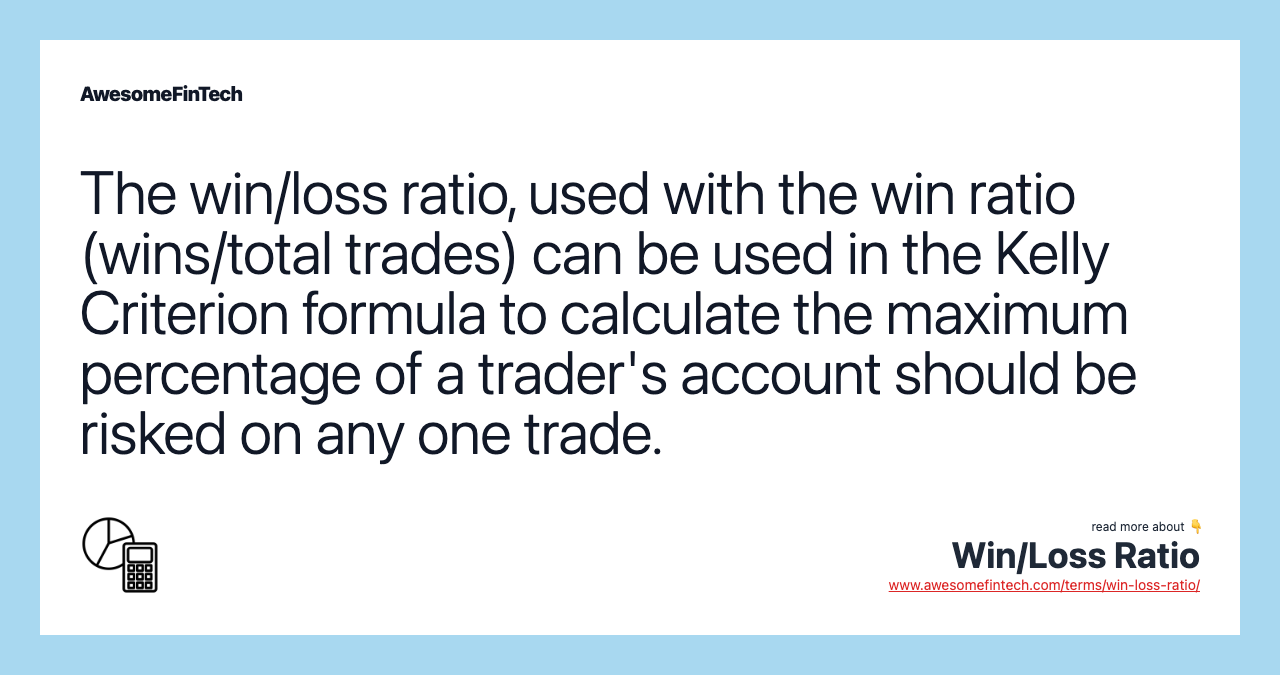Win/Loss Ratio
The win/loss ratio is the ratio of the total number of winning trades to the number of losing trades. Having a high win rate doesn't necessarily mean a trader will be successful or even profitable, as a high win rate means little if the risk-reward is very high, and high risk-reward ratio may not mean much if the win rate is very low. Although the win/loss ratio is used to determine the success rate and probability of future success of stock traders, it is not very useful on its own because it does not take into account the monetary value won or lost in each trade. For example, a win/loss ratio of 2:1 means the trader has twice as many winning trades as losing. It does not take into account how much was won or lost, but simply if they were winners or losers. Win/loss ratio \= Wins Losses \\text{Win/loss ratio} = \\frac{\\text{Wins}}{\\text{Losses}} Win/loss ratio\=LossesWins The win/loss ratio can also be stated as _winning trades : losing trades._ The win/loss ratio, used with the win ratio (wins/total trades) can be used in the Kelly Criterion formula to calculate the maximum percentage of a trader's account should be risked on any one trade. The win/loss ratio is used to calculate the risk/reward ratio, which is the profit potential of a trade relative to its loss potential.

What Is the Win/Loss Ratio?
The win/loss ratio is the ratio of the total number of winning trades to the number of losing trades. It does not take into account how much was won or lost, but simply if they were winners or losers.



The Formula for Win/Loss Ratio Is
Win/loss ratio = Wins Losses \text{Win/loss ratio} = \frac{\text{Wins}}{\text{Losses}} Win/loss ratio=LossesWins
The win/loss ratio can also be stated as winning trades : losing trades. The win/loss ratio is also known as the "success ratio."
What the Win/Loss Ratio Can Tell You
The win/loss ratio is used mostly by day traders to assess their daily wins and losses from trading. It is used with the win-rate, that is, the number of trades won out of total trades, to determine the probability of a trader’s success. A win/loss ratio above 1.0 or a win-rate above 50% is usually favorable.
Example of How to Use the Win/Loss Ratio
Assume that you have made 30 trades, of which 12 were winners and 18 were losers. This would make your win/loss ratio 12/18, which reduces to 2/3 or 2:3. In percentage format, the win/loss rate is 12/18 = 2/3 = 0.67, which means that you are losing 67% of the time. Using your total number of trades (30), your win-rate, or probability of success, would be 12/30 = 40%.
The win/loss ratio is used to calculate the risk/reward ratio, which is the profit potential of a trade relative to its loss potential. The profit potential of a trade is determined by the difference between the entry price and the targeted exit price at which a profit will be made. The trade is executed using a stop-loss order set at the target exit price, and the profit is determined by the difference between the entry point and the stop-loss price.
For example, a trader purchases 100 shares of a company for $5.50 and places a stop loss at $5.00. The trader also places a sell limit order to execute when the price hits $6.50. The risk on the trade is $5.50 - $5.00 = $0.50, and the potential profit is $6.50 - $5.50 = $1.00. The trader is, thus, willing to risk $0.50 per share to make a profit of $1.00 per share after closing the position.
The risk/reward ratio is $0.50/$1.00 = 0.5. In this case, the trader’s risk is half of his potential payoff. If the ratio is greater than 1.0, it means the risk is greater than the profit potential on the trade. If the ratio is less than 1.0, then the profit potential is greater than the risk.
Having a high win rate doesn't necessarily mean a trader will be successful or even profitable, as a high win rate means little if the risk-reward is very high, and high risk-reward ratio may not mean much if the win rate is very low.
Limitation of the Win/Loss Ratio
Although the win/loss ratio is used to determine the success rate and probability of future success of stock traders, it is not very useful on its own because it does not take into account the monetary value won or lost in each trade.
For example, a win/loss ratio of 2:1 means the trader has twice as many winning trades as losing. Sounds good, but if the losing trades have dollar losses three times as large as the dollar gains of the winning trades, the trader has a losing strategy.
Related terms:
Day Trader
Day traders execute short and long trades to capitalize on intraday market price action, which result from temporary supply and demand inefficiencies. read more
Entry Point
Entry point refers to the price at which an investor buys or sells a security. read more
Profit/Loss Ratio
Profit/loss ratio is the ratio that acts like a scorecard for an active trader whose primary goal is maximum trading gains. read more
Risk/Reward Ratio
The risk/reward ratio is used by many investors to compare the expected returns of an investment with the amount of risk undertaken to capture these returns. read more
SPOT Premium
The SPOT premium is the money an investor pays to a broker in order to purchase a single payment options trading (SPOT) option. read more
Swing Trading
Swing trading is an attempt to capture gains in an asset over a few days to several weeks. Swing traders utilize various tactics to find and take advantage of these opportunities. read more
Triple Top
A triple top is a technical chart pattern that signals an asset is no longer rallying, and that lower prices are on the way. read more
Unlimited Risk
Unlimited risk is when the risk of an investment is unlimited, although steps can be taken to help control actual losses. read more